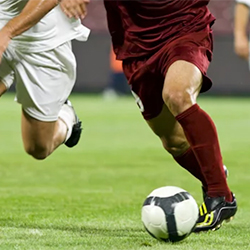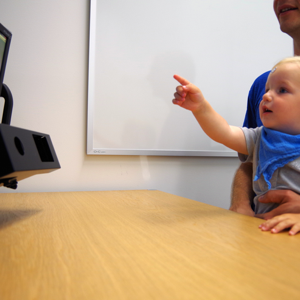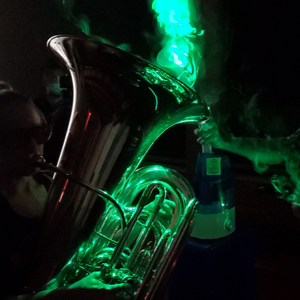By Marie Rosenthal, MS
Today’s roundup is all about people, and how the pandemic affected various groups. From traveling overseas for unconventional treatment for long COVID to wondering about infant development, COVID-19 has affected many aspects of our daily lives. We look at some of the groups affected. We have professional soccer players having trouble getting back in the game, and people traveling to private clinics in Europe to get their “blood cleaned” because they are suffering debilitating symptoms of long COVID. Despite the isolation practiced during the pandemic, infants seemed to have fared pretty well developmentally, according to a team in Zurich. And finally, the Philadelphia Orchestra found it got closer after this study.
Soccer Players Fought Fatigue for 6 Weeks After COVID Infection
Matchday performance of professional soccer players dropped after recovering from COVID-19, with three-fourths fighting fatigue for six weeks, a University of Essex study has found (Physiol Rep 2022;10[11]:e15337 https://physoc.onlinelibrary.wiley.com/doi/10.14814/phy2.15337).

The researchers explored the impact of long COVID on elite athletes. They found 77% of those studied fought general fatigue for 37 days, and 54% battled muscle fatigue for 38 days after testing negative.
GPS data from 10 games after they returned to play found a 4% decline in match performance—despite no drop in lung capacity.
Michele Girardi, PhD, who collaborated with the University of Essex School of Sport, Rehabilitation, and Exercise Sciences, in England, and worked with colleagues in Italy to study players in the Italian Serie C league. One anonymous club opened its doors to a team of researchers, which also included academics from the University of Padua, University of Rome “Foro Italico,” University of Verona and University College London.
They collected data about 13 players who were infected with COVID-19 over the course of roughly six months. They had an average age of 24 years, were just under 6 feet tall and weighed around just more than 168 pounds.
“Although this is a relatively small sample size, this is vital data, which shows more needs to be done to understand the impact of COVID on young healthy people,” Dr. Girardi said.
He said professional athletes were almost the “canaries in the coal mine” because they were in a unique position during the pandemic, often playing when others were sequestered.
“The world of football was very unusual as when we all had to self-isolate from everyone they continued to train, meet in groups and play,” Dr. Girardi said.
“One original aspect is that we studied players’ metabolic power during official matches following the infection,” Dr. Girardi said. “We were surprised to see such an impact on players’ capacity to exercise at high intensities.”
He said coaches should consider fatigue carefully to ensure an effective “return to sport” after COVID-19.
“The virus has not gone away, and sports teams are high-risk environments, which can act as real vectors for infection.”
He hopes the study will be expanded with more teams taking part to understand the impact of the coronavirus.
‘Blood Washing’ Treatments
Long-COVID patients are seeking experimental “blood washing” treatment abroad, an investigation by the BMJ and ITV News found (BMJ2022;378:o1671).
Thousands of people experiencing the debilitating symptoms of long COVID are traveling to private clinics in Cyprus, Germany and Switzerland to seek costly but unproven treatments, such as apheresis, advertised as blood washing.
But experts question whether these invasive therapies should be offered without sufficient evidence.
The full report by ITV News Science Editor Deborah Cohen aired on July 13 on “ITV Evening News” at 6.30 p.m. and “ITV News at Ten.”
The World Health Organization estimates that between 10% and 20% of patients suffer symptoms for at least two months after an acute COVID-19 infection. The CDC estimates that one in five Americans also has long COVID.
Currently, there is no internationally agreed treatment pathway for the condition.
Apheresis involves inserting needles into each arm and passing the blood over a filter, separating the red blood cells from the plasma. The plasma is filtered before being recombined with the red blood cells and returned to the body via a different vein.
The investigation includes details of people who have tried the treatment, such as Gitte Boumeester, a trainee psychiatrist in the Netherlands, who developed severe long-COVID symptoms that were so debilitating she was forced to quit her job in November 2021. After visiting the Long Covid Center in Cyprus to receive the treatment, which cost more than $50,000, she returned home with no improvement to her symptoms. She received six rounds of apheresis, as well as nine rounds of hyperbaric oxygen therapy, and an IV vitamin drip at the private Poseidonia clinic, adjacent to the center.
She was also advised to buy hydroxychloroquine as an early treatment package in case she was reinfected with COVID-19, despite a Cochrane review published in March 2021 concluding that it is “unlikely” the drug has a benefit in the prevention of COVID-19.
“We as a clinic do neither advertise, nor promote. We accept patients that have microcirculation issues and want to be treated with H.E.L.P. apheresis. … If a patient needs a prescription, it is individually assessed by our doctor or the patient is referred to other specialized doctors where needed,” Marcus Klotz, the co-founder of the Long Covid Center told the BMJ.
A spokesperson for the Poseidonia clinic said all treatments offered are “always based on medical and clinical evaluation by our doctors and clinical nutritionist, diagnosis via blood tests with lab follow-ups as per good medical practice.”
Although some doctors and researchers believe apheresis and anticoagulation drugs may be promising treatments for long COVID, others worry desperate patients are spending life-changing sums on invasive, unproven treatments.
Shamil Haroon, MBChB, PhD, MPH, BMedSci, MFPH, a clinical lecturer in primary care at the University of Birmingham, in England, and a researcher on the TLC (Therapies for Long-COVID in Non-hospitalized patients) trial, said “experimental” treatment should only be done in the context of a clinical trial.
“It’s unsurprising that people who were previously highly functioning, who are now debilitated, can’t work, can’t financially support themselves, would seek treatments elsewhere,” he said. “It’s a completely rational response to a situation like this. But people could potentially go bankrupt accessing these treatments, for which there is limited to no evidence of effectiveness.”
Social Development of Infants Appears Unaffected by COVID-19 Pandemic
The pandemic has had a profound impact on our social lives. Almost overnight, people started to work from home, keep their distance and cover half their face with surgical masks. This affected small children, teenagers and adults alike. And yet, there has been very little research into the effects of pandemic-related changes on infants (Infancy 2022 Jun 29. doi: 10.1111/infa.12488).
 A 12-month-old child during a study using eye tracking to analyze gaze behavior. Source: University of Zurich.
A 12-month-old child during a study using eye tracking to analyze gaze behavior. Source: University of Zurich.
“This ability is fundamental for engaging in social interactions, building relationships and developing language skills,” said Stephanie Wermelinger, Dr. Phil, who researches developmental psychology in infants and children in the Department of Psychology at the University of Zurich. If this ability is impaired, it can hamper a person’s ability to interact with society, as is the case for people with autism.
Eighty infants between the age of 12 and 15 months took part in the study. They were shown different videos in which a person was gazing at one of two objects. By tracking the infants’ eye movements, the researchers recorded how often and quickly the infants followed the person’s gaze. They then compared their data with eye movement data from 133 children using the same method before the pandemic.
The study showed no significant behavioral differences between the children born during and before the pandemic. Children born during the pandemic followed a person’s gaze just as often and quickly as those in the pre-pandemic group. Although the pandemic meant that the children saw fewer people overall and interacted with more people who were wearing masks, they don’t seem to be developing any differently from children who didn’t experience any pandemic-related changes.
“We believe the unchanged social interactions with parents and caregivers at home are enough to mitigate any influence the COVID-19 pandemic might have had on infants,” Dr. Wermelinger said. These contacts could thus be sufficient to provide infants with the social input they need to develop social and emotional skills such as gaze following.
Making Music and Spewing Aerosols
If simply breathing can spread the SARS-CoV-2 virus to others nearby, what about blowing into a tuba? Researchers from the University of Pennsylvania used fluid mechanics to study the movement of aerosols generated by professional musicians after Penn scientists Paulo Arratia, PhD, and Douglas Jerolmack, PhD, answered a call for help from the Philadelphia Orchestra.
The Philadelphia Orchestra, like so many cultural institutions, suspended performances due to the pandemic in 2020. Through P.J. Brennan, the chief medical officer of the University of Pennsylvania Health System, the orchestra sought expertise to help understand whether its musicians could return to playing in a safe physical arrangement that would minimize the chances of exposing one another, or their audiences, to SARS-CoV-2 (Phys Fluids 2022 Jul 6. doi:10.1063/5.0098273).
 Members of the Philadelphia Orchestra, including Carol Jantsch, principal tuba player, took part in a study led by Penn scientists Paulo Arratia, PhD, and Douglas Jerolmack, PhD. Their investigation examined the aerosols professional musicians generate as they play. Courtesy of Paulo Arratia
Members of the Philadelphia Orchestra, including Carol Jantsch, principal tuba player, took part in a study led by Penn scientists Paulo Arratia, PhD, and Douglas Jerolmack, PhD. Their investigation examined the aerosols professional musicians generate as they play. Courtesy of Paulo Arratia
The musicians reported problems hearing one another and poor sightlines with plastic glass dividers. “The challenge was, how can we get away from this to the point where they can play unobstructed but still safely?” Dr. Arratia said.
The researchers said their study suggests the aerosols musicians produce dissipate within about six feet. The results not only informed the arrangement of the Philadelphia Orchestra as they resumed performances in the summer of 2020 but also laid the groundwork for how other musical groups might think about safely gathering and playing.
The research hinged on the questions of how many aerosol particles the musicians generated, how densely the particles were emitted from the instruments, and how fast they traveled through the air.
“You can have a big jet of air coming out, but if the aerosol concentration is very low it doesn’t much matter,” said Dr. Jerolmack, of Penn’s School of Arts and Sciences. “Or you can have a lot of aerosols that get concentrated in a narrow beam. Those things are important to understand.”
To gather data, the researchers invited orchestra musicians to the campus, bringing along their wind instruments, including flutes, tubas, clarinets, trumpets, oboes and bassoons.
To visualize and track the aerosols flowing out of the instruments as the musicians played, the researchers operated a humidifier that emitted water vapor droplets at the bell end of the instruments. This arrangement was only shifted for the flute player, for whom the humidifier was placed near the musician’s mouth instead of the bell, since air travels over the mouthpiece while playing that instrument.
The researchers then shone a laser beam through the “fog” created by the humidifier, lighting up the aerosol particles and allowing them to be captured by a high-speed camera and particle counter.
The musicians played scales continuously for two minutes. It proved somewhat surprising to the researchers to find that the wind instrument musicians produced aerosols that were similar in concentration to those emitted during normal breathing and speaking, from about 0.3 to 1 mcm in diameter.
Particles of this size, according to the researchers, are small enough to travel far through the air, provided the air flow is strong enough to take them there. Thus, measuring their concentration and the flow became important to understand the potential risk of a musician potentially passing SARS-CoV-2 to another person.
Evaluating the velocity of the flow, the researchers measured speeds of roughly 0.1 m per second, orders of magnitude slower than that of a cough of sneeze, which can travel 5 to 10 m per second. The flute was an outlier but still only reached flow speeds of around 0.7 m per second.
Based on their observations, the aerosols produced by these “mini-concerts” dissipated, settling into the flow of the background air draft, within about 2 m, or 6 feet—reassuringly similar, the researchers said, to what has been measured for ordinary speaking or breathing. Only flute- and trombone-generated aerosols traveled beyond that distance, for the flute perhaps because the air travels over the instrument instead of the instrument acting like a mask to prevent the spread of aerosols.
Overall, woodwind instruments emitted slightly lower concentrations of aerosols than brass instruments, perhaps because the wooden elements of the instrument absorbed some of the humidity, and the numerous holes along the instrument may reduce the flow of some of the aerosols, the researchers speculated.
Because the measurements the researchers made were not connected to any specific quality of SARS-CoV-2, they can be used to extrapolate how transmission of other respiratory pathogens could be affected by making music, they said.


